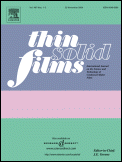Self-assembled mono- and multilayers of monodisperse cationic and anionic latex particles
Karl-Ulrich Fulda, Achim Kampes, Lutz Krasemann, Bernd Tieke
Monolayer formation upon self-assembly of monodisperse anionic latex particles and multilayer formation upon alternating self-assembly of cationic and anionic latex particles at positively charged glass supports were studied using scanning electron microscopy (SEM). Particles were prepared by soap-free emulsion copolymerization of styrene with acrylic acid (1a, 1b), and styrene with 2-acryloxyethyl-trimethylammonium bromide (2) having diameters of 440 (1a) and 200 nm (1b, 2). Interfacial adsorption of la leads to adsorption of isolated particles and small two-dimensional (2D) aggregates. A normalized surface coverage C-s of 30% is reached, the average particle aggregate size being 5. Alternate dipping into dispersions of particles 1b and 2 with identical diameter of 200 nm leads to successive formation of a highly porous, amorphous 3D film. The thickness increases with the number n of dipping processes, but is only 60% of the value calculated for a densely packed array of n layers. (C) 1998 Elsevier Science S.A. All rights reserved.
Keywords: monolayers; multilayers; self-assembly; scanning electron microscopy
Thin Solid Films, 1998, Vol 329, pp 752-757
Elsevier Science SA, PO Box 564, 1001 Lausanne, Switzerland
Copyright © 1998 Elsevier Science S.A. All rights reserved.
